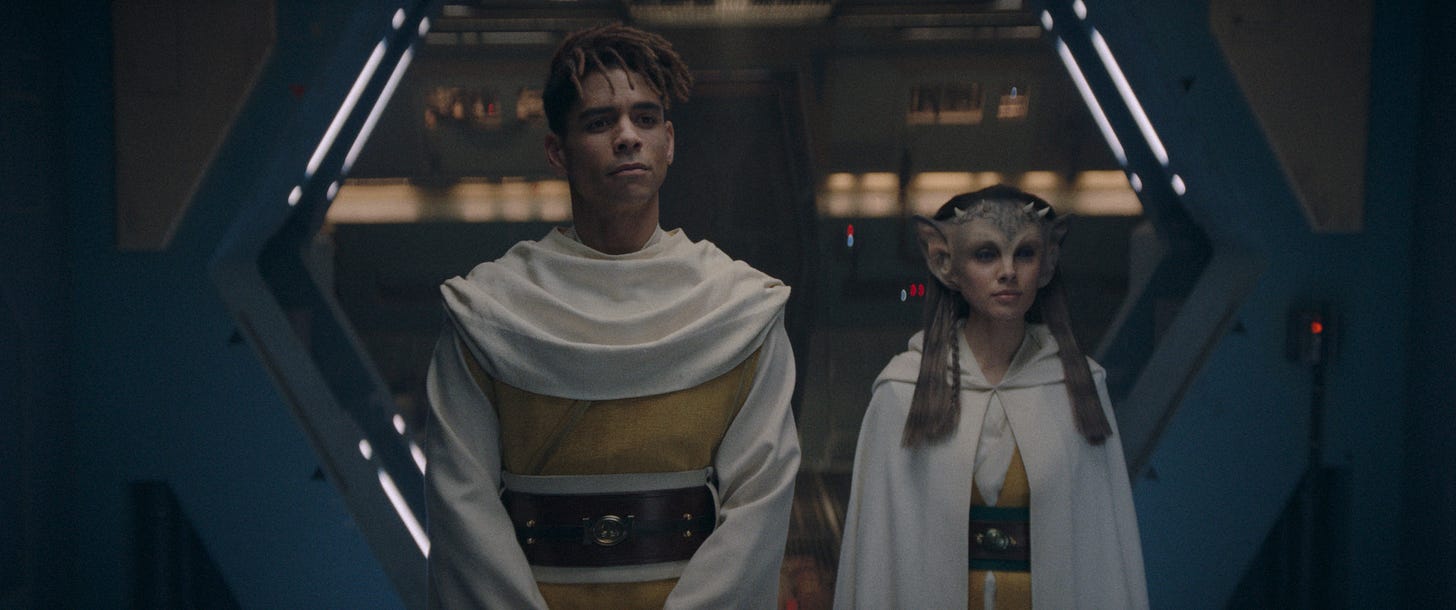The Acolyte Episodes 1 & 2 Review: Who Killed Laura Pol-Mher?
Star Wars tries the murder-mystery genre
I stayed up too late watching the first two episodes of The Acolyte. So in an attempt to keep this review orderly and logical, I’m going to structure it like a philosophy paper.
First, a premise: Television is an inferior medium to film. I think it’s telling that in this supposed Golden Age of Television, shows just look more and more like unedited movies. I wish Star Wars was still a film series, and not a streaming TV franchise.
Secondly, the exception that proves the rule: Twin Peaks is as good or better than any movie.
Finally: The Acolyte is trying to be the Twin Peaks of Star Wars.
Both series start with a murder. Then an eccentric-and-handsome lawman (FBI Agent Dale Cooper in TP/Jedi Knight Yord Fandar in TA) team up with a gruff counterpart who has a more personal interest in the case (Sheriff Harry S. Truman/Jedi Master Sol).
Twin Peaks drew me in right away. The Acolyte bored me instantly. Maybe it has to do with one notable difference: David Lynch never wanted Laura Palmer’s murder to be solved. In The Acolyte, the identity of the killer (Mae) and a decent chunk of her backstory get spoon-fed to the viewer during these first two episodes.
I appreciate the writers quickly revealing that Mae and the show’s protagonist are twins, and not a single person living out a Tyler Durden situation. (The good twin is named Osha—perhaps a goofy reference to her dangerous spaceship-repair job.) Better to tell the audience in the first act that Kylo Ren is Han Solo’s son. Anything else feels like too deliberate of an attempt to replicate “No, I am your father.”
But! When creating a murder mystery show, the decision to solve the murder mystery almost immediately risks letting all the air out of the balloon. Twin Peaks could have gotten away with Lynch’s plan to string viewers along indefinitely because the story springboards off the original murder into a vibes-based exploration of the nature of evil. I’m not foreclosing on the possibility The Acolyte will take a similarish turn. Clearly, the show has something to say about the High Republic Jedi, who come off as cold Zen masters clinging to their political power.
Still, Twin Peaks is great from the jump. So I went back to its very beginning to reflect on what the show did so well.
It’s a simple shot: Dale Cooper drives along a highway in the Pacific Northwest while recording a tape he will mail his assistant, Diane, back east. Sultry jazz plays softly in the background. Cooper comments on the high quality of the cherry pie and trees he’s encountered on his trip.
Here’s another similarity between Twin Peaks and The Acolyte: They try to portray a creeping evil infiltrating an idyllic setting. The viewer enters the town of Twin Peaks with Agent Cooper and—through the show’s soap opera structure—becomes just as invested in small-town life in the Pacific Northwest as in the murder.
This contrast is at the heart of the Lord of the Rings films, which yearn to return to the verdant shire shown in Fellowship. More recently, in Furiosa, George Miller shows us a sliver of paradise before its lost to a desert of evil. Notably, this trope is not very Lucasian, as characters in American Graffiti and Star Wars can’t wait to leave their hometowns.
I think The Acolyte fumbled a bit by starting off in a bar—a setting much more appropriate for The Mandalorian’s immaculate intro. Where’s the shire, the pre-Palpatine Eden we should be afraid to lose?
David Lynch once told GQ that Kyle MacLachlan, “Is the person you trust enough to go into a strange world with.” So far, the High Republic isn’t a strange enough world. Nor am I sure which character I trust to lead me there.




